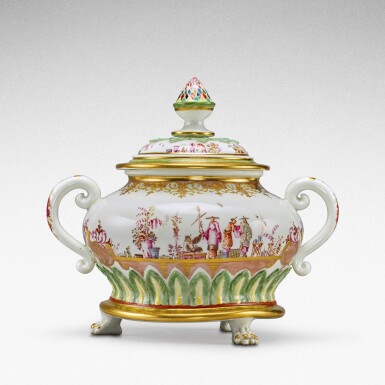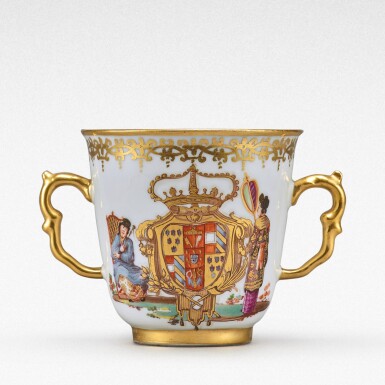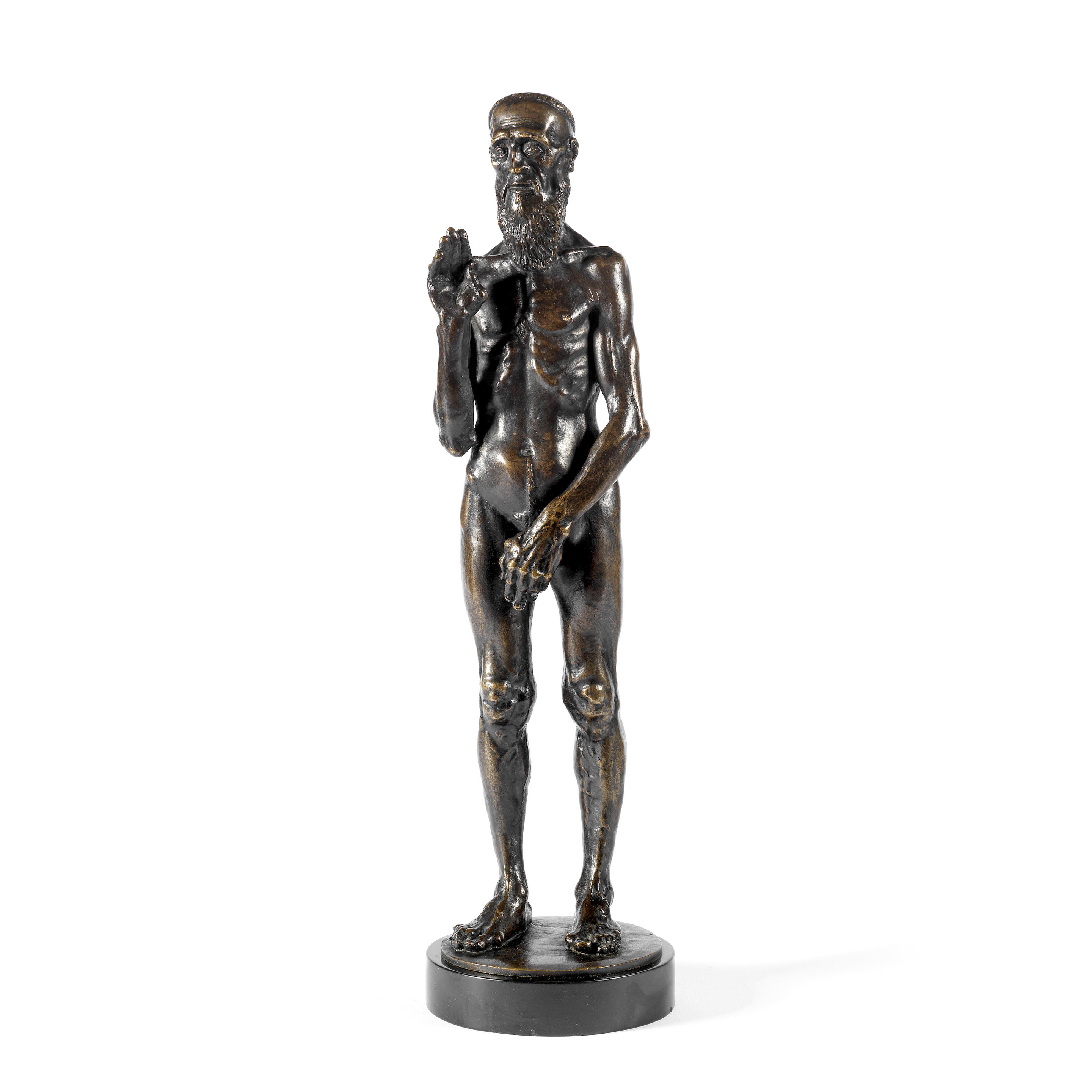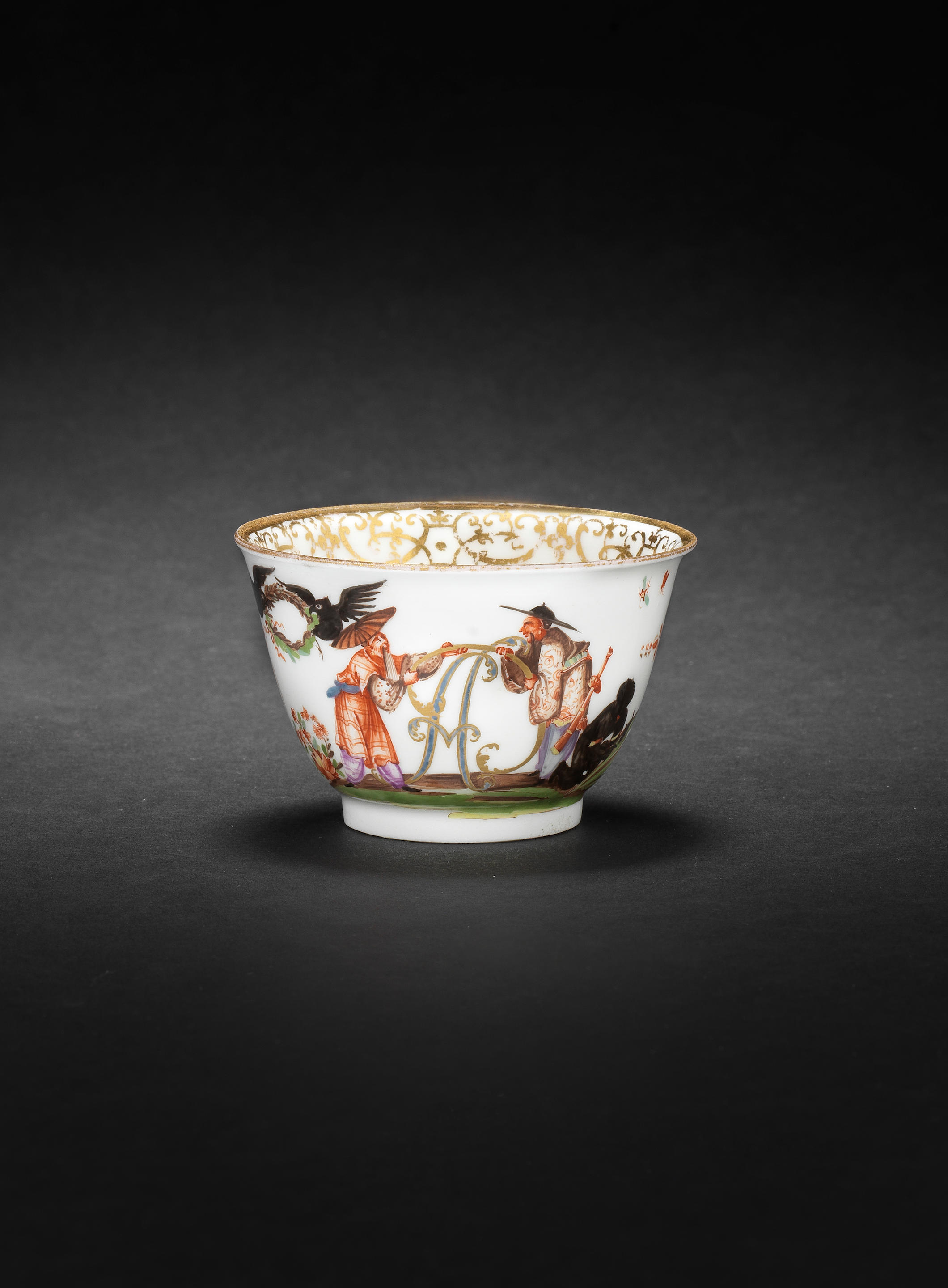An extremely rare Meissen armorial two-handled beaker from the service made for Elizabeth Farnese, Queen of Spain, Circa 1737 similarly decorated to the preceding lot, crossed swords mark in underglaze-blue, two dots in gilding.Height: 2⅝ in.6.7 cmCondition reportFor further information please contact oppenheimer@sothebys.com; +1 212 894 1442.ProvenanceGift of Augustus III, King of Poland and Elector of Saxony, to Elisabeth Farnese, Queen of Spain, on the occasion of his daughter's marriage to the King of Naples;Wilhelm von Bode, Charlottenburg;The Royal Collections of Saxon, Johanneum, Dresden (acquired from Bode in 1901);Margarethe (née Knapp, 1878-1949) and Dr. Franz (1871-1950) Oppenheimer, Berlin & Vienna (no. 262 in red);Dr. Fritz Mannheimer (1890-1939), Amsterdam & Paris, inv. no. Por. 342 a/b (acquired between 1936 and 1939);Dienststelle Mühlmann, The Hague (acquired from the Estate of the above in 1941 on behalf of the Sonderauftrag Linz for the proposed Führermuseum);On deposit at Kloster Stift Hohenfurth;On deposit at Salzbergwerk Bad Aussee;Recovered from the above by Allied Monuments Officers and transferred to the Central Collecting Point Munich (MCCP inv. no. 1571/20);Repatriated from the above to Holland between 1945 and 1949;Loaned by the Dutch State to the Rijksmuseum, Amsterdam in 1952 and transferred to the museum in 1960;Restituted by the above to the heirs of Margarethe and Franz Oppenheimer in 2021LiteratureGustav E. Pazaurek, Meissner Porzellanmalerei des 18. Jahrhunderts, Stuttgart, 1929, p. 43Franz Kieslinger, Sichergestellte Kunstwerke in den besetzten niederländischen Gebieten, Vienna, 1941, no. 373Staatliche Kunstsammlungen Dresden, Der Menschheit bewahrt: Schätze der Weltkultur, exh. cat., Dresden, 1959, no. A229 or A233Hermann Jedding, Europäisches Porzellan, Vol. I Von den Anfängen bis 1800, Munich, 1971/1979, fig. 74Ingelore Menzhausen, Alt-Meissner Porzellan in Dresden, Berlin, 1988, p. 201, pl. 63Günter Reinheckel, Prachtvolle Service aus Meissner Porzellan, Leipzig, 1989, pl. 42Ulrich Pietsch, Johann Gregorius Höroldt 1696-1775 und die Meissener Porzellanmalerei, exh. cat., Dresden, 1996, nos. 163-77Abraham L. den Blaauwen, Meissen porcelain in the Rijksmuseum, Amsterdam, 2000, p. 178, cat. no. 104ExhibitedDresden, Albertinum, 1959, no. A229 or A233Catalogue noteIn May 1738, Augustus III's daughter, the 14-year-old Princess Maria Amalia of Saxony (1724-1760), was married, by proxy, in Dresden, to Charles VII (1716-1788), King of Naples. Shortly thereafter she set out on the month long journey to her new home in Italy, accompanied by her older brother, the crippled Crown Prince Friedrich Christian who was travelling incognito to an island off the coast of Naples in hope of a cure. In celebration of the marriage, Augustus presented his young daughter with the gift of a silver toilette service which included Meissen armorial tea and chocolate wares. The marriage had been orchestrated by Charles' ambitious mother, Elisabeth Farnese (1692-1766), Queen of Spain, who wanted to keep control of the courts of Savoy and Naples, as well as Spain, within her family. She too received a gift from Augustus, a substantial group of Meissen porcelain, so numerous in size that it filled seventeen boxes and which included a service decorated with her family's arms. The gift itself was somewhat tinted by scandal. According to a surviving packing list it was prepared for shipment by June 29, 1738 and its delivery to Madrid was entrusted by Count von Brühl, director of the Meissen factory, to a Frenchman named Velasco. However, unbeknownst to Brühl, Velasco was a swindler, who was wanted by most of the courts of Europe, and who had already embezzled four million florins from the Spanish ambassador to The Hague. Upon learning of his misjudgment, "Wanted" posters for Velasco appeared throughout Europe describing him as "of around twenty-four, small, well built, tanned, blond, brown eyebrows, blue eyes...". He and th
An extremely rare Meissen armorial two-handled beaker from the service made for Elizabeth Farnese, Queen of Spain, Circa 1737 similarly decorated to the preceding lot, crossed swords mark in underglaze-blue, two dots in gilding.Height: 2⅝ in.6.7 cmCondition reportFor further information please contact oppenheimer@sothebys.com; +1 212 894 1442.ProvenanceGift of Augustus III, King of Poland and Elector of Saxony, to Elisabeth Farnese, Queen of Spain, on the occasion of his daughter's marriage to the King of Naples;Wilhelm von Bode, Charlottenburg;The Royal Collections of Saxon, Johanneum, Dresden (acquired from Bode in 1901);Margarethe (née Knapp, 1878-1949) and Dr. Franz (1871-1950) Oppenheimer, Berlin & Vienna (no. 262 in red);Dr. Fritz Mannheimer (1890-1939), Amsterdam & Paris, inv. no. Por. 342 a/b (acquired between 1936 and 1939);Dienststelle Mühlmann, The Hague (acquired from the Estate of the above in 1941 on behalf of the Sonderauftrag Linz for the proposed Führermuseum);On deposit at Kloster Stift Hohenfurth;On deposit at Salzbergwerk Bad Aussee;Recovered from the above by Allied Monuments Officers and transferred to the Central Collecting Point Munich (MCCP inv. no. 1571/20);Repatriated from the above to Holland between 1945 and 1949;Loaned by the Dutch State to the Rijksmuseum, Amsterdam in 1952 and transferred to the museum in 1960;Restituted by the above to the heirs of Margarethe and Franz Oppenheimer in 2021LiteratureGustav E. Pazaurek, Meissner Porzellanmalerei des 18. Jahrhunderts, Stuttgart, 1929, p. 43Franz Kieslinger, Sichergestellte Kunstwerke in den besetzten niederländischen Gebieten, Vienna, 1941, no. 373Staatliche Kunstsammlungen Dresden, Der Menschheit bewahrt: Schätze der Weltkultur, exh. cat., Dresden, 1959, no. A229 or A233Hermann Jedding, Europäisches Porzellan, Vol. I Von den Anfängen bis 1800, Munich, 1971/1979, fig. 74Ingelore Menzhausen, Alt-Meissner Porzellan in Dresden, Berlin, 1988, p. 201, pl. 63Günter Reinheckel, Prachtvolle Service aus Meissner Porzellan, Leipzig, 1989, pl. 42Ulrich Pietsch, Johann Gregorius Höroldt 1696-1775 und die Meissener Porzellanmalerei, exh. cat., Dresden, 1996, nos. 163-77Abraham L. den Blaauwen, Meissen porcelain in the Rijksmuseum, Amsterdam, 2000, p. 178, cat. no. 104ExhibitedDresden, Albertinum, 1959, no. A229 or A233Catalogue noteIn May 1738, Augustus III's daughter, the 14-year-old Princess Maria Amalia of Saxony (1724-1760), was married, by proxy, in Dresden, to Charles VII (1716-1788), King of Naples. Shortly thereafter she set out on the month long journey to her new home in Italy, accompanied by her older brother, the crippled Crown Prince Friedrich Christian who was travelling incognito to an island off the coast of Naples in hope of a cure. In celebration of the marriage, Augustus presented his young daughter with the gift of a silver toilette service which included Meissen armorial tea and chocolate wares. The marriage had been orchestrated by Charles' ambitious mother, Elisabeth Farnese (1692-1766), Queen of Spain, who wanted to keep control of the courts of Savoy and Naples, as well as Spain, within her family. She too received a gift from Augustus, a substantial group of Meissen porcelain, so numerous in size that it filled seventeen boxes and which included a service decorated with her family's arms. The gift itself was somewhat tinted by scandal. According to a surviving packing list it was prepared for shipment by June 29, 1738 and its delivery to Madrid was entrusted by Count von Brühl, director of the Meissen factory, to a Frenchman named Velasco. However, unbeknownst to Brühl, Velasco was a swindler, who was wanted by most of the courts of Europe, and who had already embezzled four million florins from the Spanish ambassador to The Hague. Upon learning of his misjudgment, "Wanted" posters for Velasco appeared throughout Europe describing him as "of around twenty-four, small, well built, tanned, blond, brown eyebrows, blue eyes...". He and th














Testen Sie LotSearch und seine Premium-Features 7 Tage - ohne Kosten!
Lassen Sie sich automatisch über neue Objekte in kommenden Auktionen benachrichtigen.
Suchauftrag anlegen